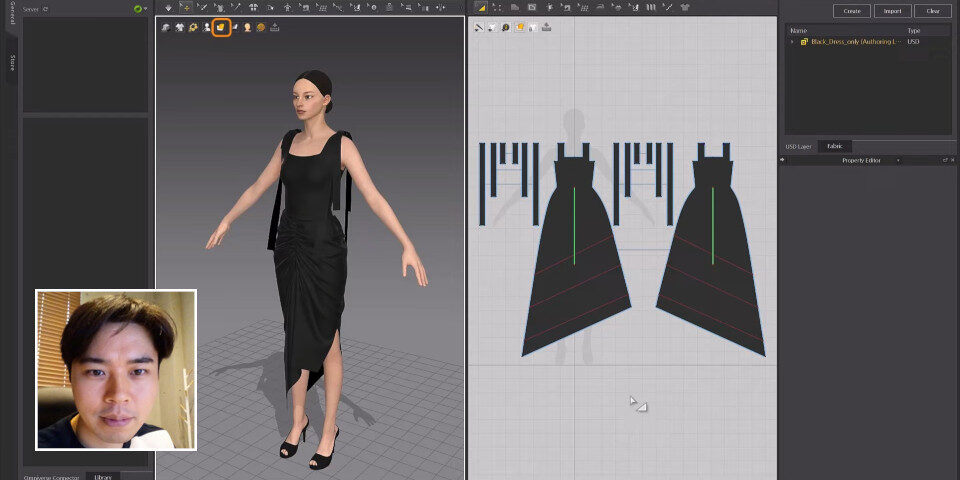Marvelous Designer creator wins Sci-Tech Academy Award

CLO Virtual Fashion co-founder Jaden Oh has won a Scientific and Technical Academy Award for his work on 3D clothing creation software Marvelous Designer.
Other Sci-Tech awards – the Oscars of the technology world – go to the creators of key open standards in VFX and feature animation, including USD, OpenVDB and Alembic.
The physical awards will be presented at a ceremony in Hollywood next month.
Marvelous Designer: from digital cosplay tool to Sci-Tech Award-winnning app
Marvelous Designer becomes the latest CG application to be recognized at the Scientific and Technical Awards.
The software enables artists to create digital clothing using a workflow similar to that for physical garments, stitching together virtual 2D pattern pieces and draping the fabric over a 3D avatar.
Originally targeted at the cosplay community, Marvelous Designer was first adopted in movie production by Weta Digital, which used it for 2011 animated feature The Adventures of Tintin.
Since then, it has been widely used on animated features and VFX movies, including Doctor Strange in the Multiverse of Madness and Avengers: Infinity War.

(Inset) CLO Virtual Fashion founder Jaden Oh, and the software he helped create, Sci-Tech Award-winnning 3D clothing design tool Marvelous Designer.
Unusually for a Sci-Tech Award, the Academy Plaque goes to a single person, Jaden Oh, co-founder of Marvelous Designer’s developer, CLO Virtual Fashion.
Oh wrote the initial prototype for the software while still at school, going on to found CLO Virtual Fashion after completing a PhD at the Korea Advanced Institute of Science and Technology.
The Academy citation notes his role in guiding CLO Virtual Fashion’s team of engineers and UX designers to “raise the quality of appearance and motion in digital wardrobe creations”.

2016 Pixar short Piper became the first movie produced using a pipeline based around Universal Scene Description. USD is now the industry standard for exchanging complex scene data.
USD’s principal architects win an Academy Plaque
Other Academy Plaques go to the creators of two of the key open standards used in modern VFX and animation pipelines: Universal Scene Description (USD) and OpenVDB.
In the case of USD, the award goes to five Pixar staff, including team lead and chief architect Sebastian Grassia.
Developed in-house at the animation studio, and open-sourced in 2016, USD was designed as a standard format for exchanging complex scene data between applications.
It is now natively supported by the key applications used in VFX and animation production, including both proprietary software and off-the-shelf tools like Houdini and Maya.
The Academy citation describes USD as the “first open-source scene description framework capable of accommodating the full scope of the production workflow”, whose “wide adoption has made it a de facto interchange format of 3D scenes … across the motion picture industry.”
Development of USD is now overseen by the Alliance for OpenUSD, a consortium of tech giants that aims to make USD an ISO-ratified standard across a wider range of industries.
The OpenVDB sizzle reel. Developed at DreamWorks Animation, the volumetric data format is now one of the key industry technologies overseen by the Academy Software Foundation.
OpenVDB creators get their second Sci-Tech Awards
In the case of OpenVDB, the Academy Plaque goes to its principal creator and architect, Ken Museth, and two other former DreamWorks Animation staff, Peter Cucka and Mihai Aldén.
Developed in-house at DreamWorks, and open-sourced in 2012, the volumetric data format is now universally supported in VFX software, forming part of the VFX Reference Platform.
The Academy citation describes OpenVDB as a standard for “efficiently representing complex volumetric effects, such as water, fire and smoke”.
The plaque is the second Sci-Tech Award that OpenVDB has received, the same trio of developers having received an Academy Certificate in 2015.
In addition, one of this year’s certificates goes to the developers responsible for expanding OpenVDB’s feature set, including Jeff Lait, Senior Mathematician at Houdini developer SideFX.
Other awards for Alembic and Dolby Atmos developers
A further certificate goes to the creators of another, slightly older interchange standard, Alembic, including Sony Pictures Imageworks Principal Software Engineer Lucas Miller, and former Industrial Light & Magic Lead TD Christopher Horvath.
Developed at Imageworks and ILM in 2011, and also now part of the VFX Reference Platform, Alembic is widely used to exchange baked simulation and animation data between applications.
The Academy citation notes its “high-efficiency caching” of baked data “across the digital production pipeline”.
Other 2024 Scientific and Technical Awards go to the developers of technologies used in theatrical laser projection systems, and to Dolby Atmos cinema surround sound.
Read the full list of winners for 2024’s Scientific and Technical Academy Awards
Have your say on this story by following CG Channel on Facebook, Instagram and X (formerly Twitter). As well as being able to comment on stories, followers of our social media accounts can see videos we don’t post on the site itself, including making-ofs for the latest VFX movies, animations, games cinematics and motion graphics projects.
